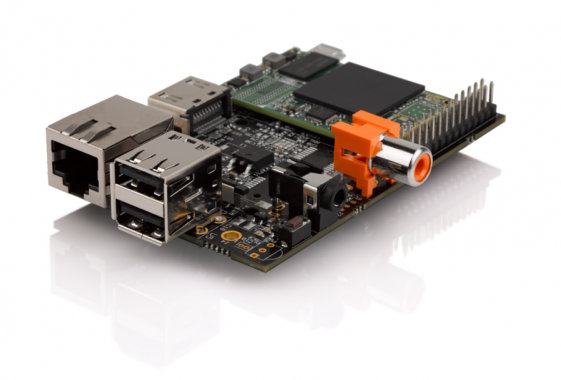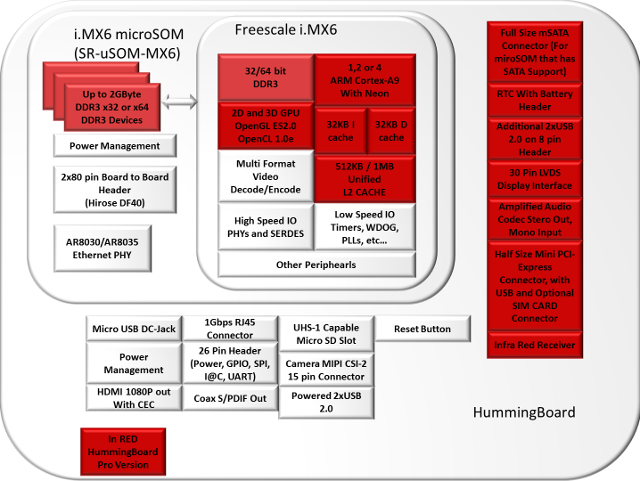HummingBoard is a board made by SolidRun that’s mechanically compatible with the Raspberry Pi, and offering the same expansions connectors, and a few extras. The board is comprised of a baseboard and a microSoM powered by Freescale i.MX6 Solo, Dual Lite or Dual. At first it looked like an internal project, but the board went viral together with the Banana Pi, and the company has now announced availability for the HummingBoard with pricing starting at $45 for the single core version up to $100 for the dual core version with extra options.

There are currently three models:
- HummingBoard-i1 ($44.90) – Freescale i.MX6 Solo with GC880 GPU, 512 MB RAM, 10/100M Ethernet
- HummingBoard-i2 ($74.99) – Freescale i.MX6 Dual Lite with GC880 GPU, 1GB RAM, 10/100M Ethernet
- HummingBoard-i2ex ($99.99) – Freescale i.MX6 Dual with GC2000 GPU, 1GB RAM, Gigabit Ethernet, LVDS output, mSATA II interface, PCI Express Gen 2 slot, RTC with baterry backup, and IR receiver
All three boards also come with an HDMI video output, two powered USB ports, a 2-Lane CSI-2 camera interface, a microSD interface, a coaxial S/PDIF output, and the same GPIO header as the Raspberry Pi. They sell with options such as 110V or 220V power adapters, or a micro SD card.Just like the Raspberry Pi, there’s no internal storage (NAND or eMMC), and instead the board boots from a micro SD card with operating systems such as Android, Ubuntu, and Debian, and it’s also likely there will be an XBMC port. The company also has Micro-SOM i4Pro with Freescale i.MX6 Quad but for some reasons (thermal dissipation?) it is not included in a HummingBoard-i4, but it can be found in Cubox-i4Pro.

The company has uploaded a promo video comparing their HummingBoard to the Raspberry Pi.
It offers a more powerful hardware with faster processing power and better peripherals, more operating systems choices including Ubuntu and Android which are not available for the Raspberry Pi, but you can’t expect the same level of software support and community as the original Raspberry Pi, and although some Raspberry Pi accessories (enclosures and expansion board) will work on the HummingBoard, you can’t expect them to all work at least without some serious software work.
You can find more information and/or purchase a board on SolidRun’s HummingBoard product page.
Thanks to dhead666 for the tip.

Jean-Luc started CNX Software in 2010 as a part-time endeavor, before quitting his job as a software engineering manager, and starting to write daily news, and reviews full time later in 2011.
Support CNX Software! Donate via cryptocurrencies, become a Patron on Patreon, or purchase goods on Amazon or Aliexpress





I quite dislike raspi I/O placement, all over board. While its nice it can be used with pi encliosures, the layout of ports.. is far from ideal.
This company has yet to deliver stable usable OS images that work on their existing products. I mean OS that you can do web browsing, workstation tasks and updates (not just ‘home theatre’) without freezing and crashing. In their forums, see the contortions and incantations customers have to go through just to boot their Cubox-i computers. It is emblematic that SolidRun’s “Getting Started” wiki link http://www.solid-run.com/getting-started/ goes nowhere.